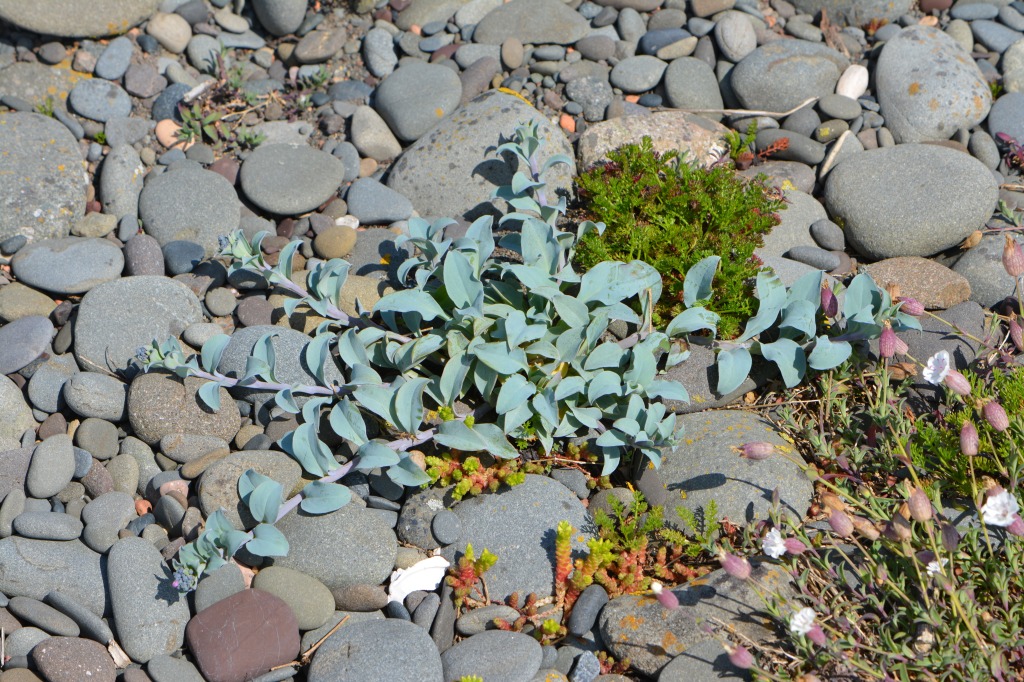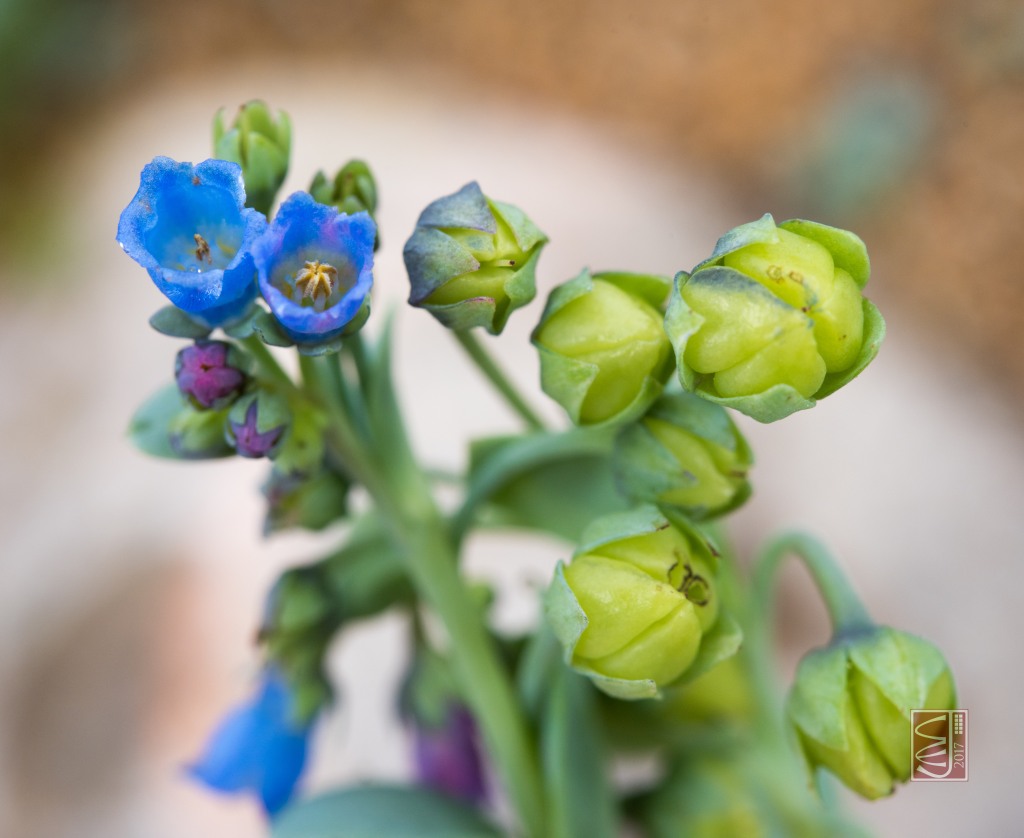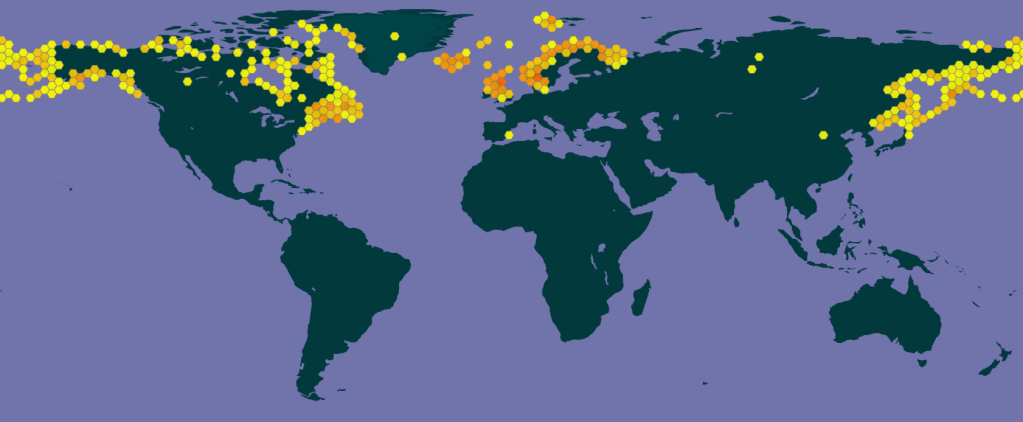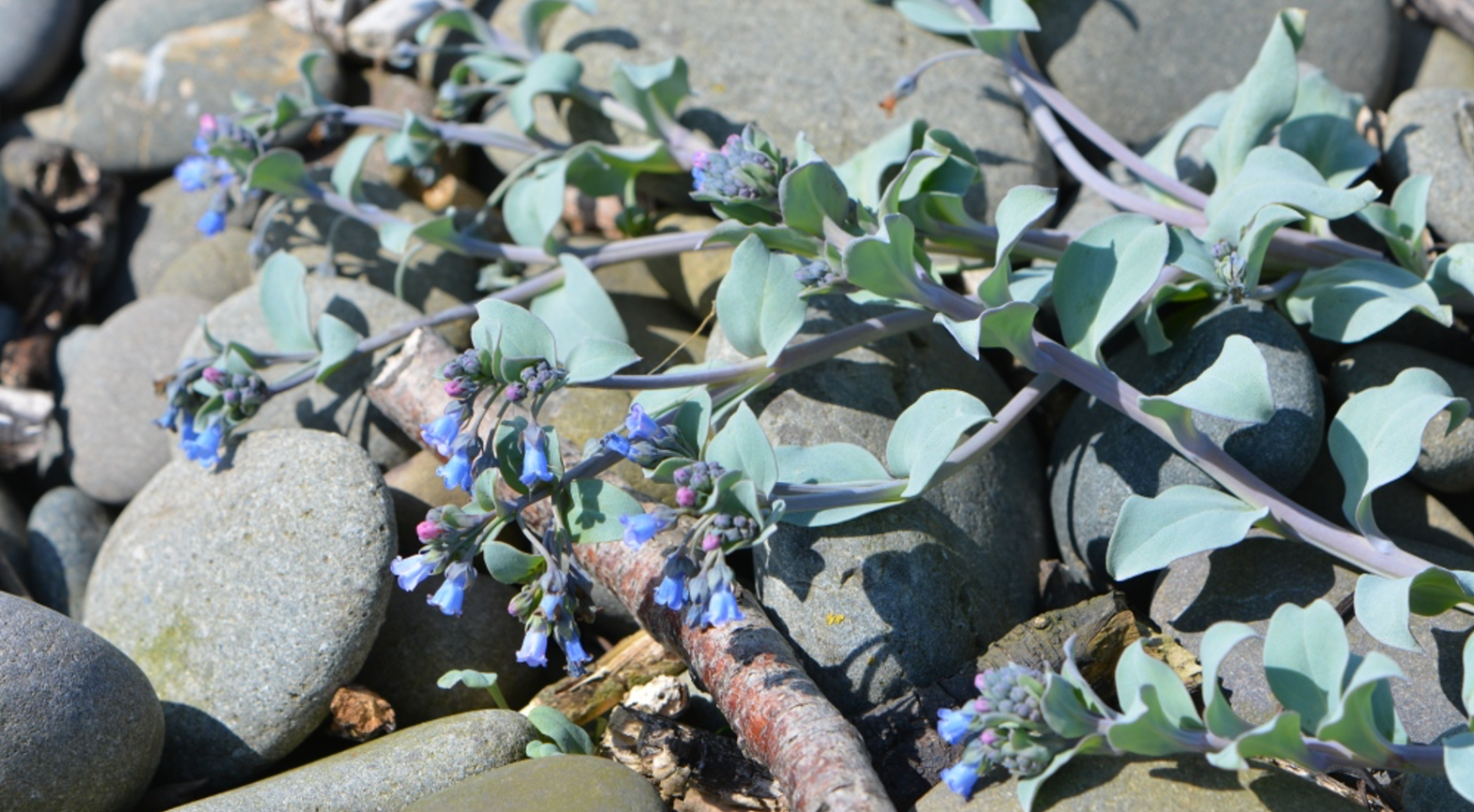This is a native species of northern coasts. It is rather rare and may become even rarer as global warming takes hold because Mertensia‘s seeds need a sharp winter’s chilling before they will germinate. It is one of several coastal species with a distinct northern distribution in Scotland. Examples are: Ligusticum scoticum (Scots lovage), Juncus balticus (Baltic rush), Carex maritima (Curved sedge) and Primula scotica (Scottish primrose).

A perennial and hairless species, the Oyster Plant belongs to the Boraginaceae; but it is quite distinctive and visually unlike all other members of that generally-hairy family. It trails on the ground and forms a prostrate cushion of blue-grey leaves (described as a ‘glaucous bloom’, to quote the very old Handbook of the British Flora by Bentham and Hooker 1920). These leaves are quite large (20-30 mm), entire, rather thick and often wavy. Its flowers are in loose terminal cymes and can be seen at the edges of each cushion from early June. As in many coastal species, the leaves are fleshy-succulent.


The flowers are pale blue, each forming a tube rather like a bluebell but much smaller. I have seen in called ‘Seaside Bluebells’ in horticultural parlance, also Northern Shore-wort is a name some people use. ‘Sea Lungwort’ is another name it goes by. Buds are usually tinged pink, as in many other members of the Borage family (examples: Lungwort, Comfrey and Forget-me-not)

It earns the name ‘Oyster Plant’ from its taste. They say it tastes of oysters. I tentatively crushed, smelt and tasted a little piece, and I think I did detect the faint salty-creamy-umami flavour associated with oysters. Chemical analysis has shown that this smell and taste is not a figment of botanists’ imaginations (Delort et al 2012). Please don’t go and eat it though, it is rare and threatened by human trampling, camper-vans, mountain bikes, off-road vehicles driven by farming lads, dogs and their humans, storms and rising sea levels.

However, its decline is not a recent phenomenon. It was already declining in the 1960s (discussed by Charles Gimingham in Burnett, 1964). It is not an easy matter to be sure of any decline in the rarer species as they may have been missed by recorders, or recorded several times by enthusiasts. However, the data base of the Botanical Society of Britain and Ireland yields a convincing tale of huge decline since 2010, particularly on the East Coast and generally in the southern part of its range. The north is by no means immune, and the decline has been going on for decades. John Anthony’s Flora of Sutherland (Kenworthy 1976) recalls seven early records from the Sutherland coast, four of which were by then ‘extinct’ and two were down to one or two individual plants. The Sutherland coastline is by no means teeming with tourists and so these declines are unexplained. An analysis of winter temperatures might be useful in the search for the cause.
It generally grows on the upper part of shingle-beaches, often with Honckenya peploides. One of its long- known locations is near Ballantrae in South Ayrshire, where it forms a colony of about 20 plants on usually-stable rather coarse shingle (2-20 cm) which is strewn with fragments of wood and debris washed up in storms. It is a remarkable spot: wave action has sculpted the terrain into ridges and hollows so that sometimes you can be standing no more than 10 metres from the sea without sight of the waves. I have visited this place several times since 2015, marvelling that any plant can withstand the violent storms that have caused historic ship-wrecks and loss of human life. In recent years I have observed the plants to be in decline.
Last year, the plants were more vigorous than usual and there were seedlings too. According to Scott (1963) a temperature of no more than 2 oC for 16 days is needed before seeds will germinate – the plant needs cold winters.

Life on pebbles that are showered with salt spray does not seem a good idea! Germination requires a seed to fall between pebbles and find sediment which contains nutrients. Once established, anchorage must become the first priority. One of Mertensia’s peculiar features is a spirally-twisted tap root extending to a depth of 60 cm (Scott 1963). Presumably this is an anchor, and with the the prostrate growth form, it helps survival during the dreadful storms. Another species that survives these conditions, and often grows alongside Mertensia is Rumex crispa. It too has a tough tap root.
It has a circumpolar distribution, although it has different subspecies names in different regions. In Japan it is subspecies asiatica, in the Russian Far-east it is czukotica, in Arctic Canada they call it subspecies tenelle and elsewhere (including the British Isles) it is subspecies maritima.

Global distribution of M. maritima, from GBIF
It is a favourite of artists http://sbac.org.uk/stories/oyster-plant/ and photographers (https://www.jeremybartlett.co.uk/2019/01/23/oysterplant-mertensia-maritima/). Gardeners like it too. You can buy seeds online.
References
Burnett JH (1964) The Vegetation of Scotland. Oliver and Boyd, Edinburgh.
Delort E, Jaquier A, Chapuis C et al. (2012) Volatile composition of Oyster Leaf (Mertensia maritima (L) Gray). Journal of Agricultural and Food Chemistry 60, 11681-11690.
Kenworthy JB (1976) John Anthony’s Flora of Sutherland. Botanical Society of Scotland.
Scott GAM (1963) Mertensia maritima (L) Gray,S.F. Journal of Ecology 51, 743-754.
©John Grace
